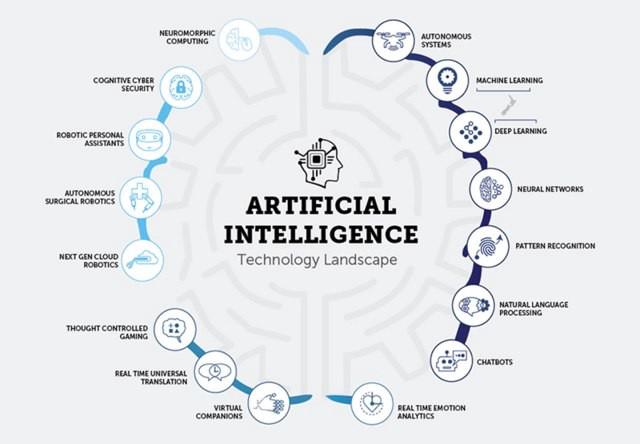Debunking technology myths for 2020
Happy New Year from all of us at NewGenApps! Since we keep writing about technology and how tech advances are changing the work landscape, we thought...


Deep learning is a category of machine learning that creates algorithms known as artificial neural systems which operate by forming the function and structure of the human mind. Deep Learning is certainly not a latest AI wonder, yet lately, as machines have turned out to be progressively smart, it has genuinely exploded, accomplishing results that are better than anyone might have expected previously, with deep neural networks also beating humans in a few situations.
Deep learning and machine learning have evolved from the corresponding roots in computer science, practicing many of the related theories and procedures. Basically, machine learning is a branch of Artificial Intelligence which allows a system to gain insight via a managed training experience.
Deep Learning along with Artificial Intelligence is the most talked about technologies recently. With giants like Google, Microsoft, and Amazon ramping up sources for research in those disciplines, the trend is clearly not going to go down anywhere around.
However, deep learning isn't just about smart machines taking control over the world. It is a tale about how smart code and algorithms are enabling PCs to perform things we never thought are reasonable.
Let's look at the top 5 deep Learning trends that will rule in the year 2019.
Big data is still vast – and continually developing. No organization has possessed the capacity to procure quick enough to keep pace with how quick their data is evolving. Basically: Data is multiplying each year; however, team sizes and budget are not.
So, 2019 will be the year when AI-augmented analytics also called automated discovery would progress toward becoming standard. Human minds aren't wired to assess a great many data sequences at sub-second speeds, yet ML is truly developed for this issue and is the ideal answer.
Organizations are progressively going to bend toward AI solutions to help oversee and analyze their information going ahead. So, 2019 will see more organizations putting resources into AI tools that empower existing groups in various functions to scale with more information effortlessly.
Machine learning is further reaching out past the current use cases of text translation as well as image labeling and starting to help organizations analyze the huge amount of information they have been gathering and saving for a considerable length of time.
More companies will be designing data pipelines which perform monotonous information structure and modeling errands that empower business clients to truly connect with these developing AI frameworks in a highly collaborative method. It will have an impact that will build the visibility of data management jobs.
A significant portion of this trend will be promoting the job of big business data management in the company, as it is data, not algorithms that is the storehouse of significant worth.
Human biases are difficult. It impacts most of the basic leadership models. Indeed, machine learning arrangements have their very own biases - sometimes they even trade off the uprightness of information and yields. It consequently sways antagonistically real-world applications.
The distinction and fluctuation of AI algorithms depend on the data sources they are served. Data scientists have arrived at the resolution that even Machine Learning methods have their very own biases that may negotiate on the respectability of their data and yields.
Artificial Intelligence biases can go unidentified for various reasons, conspicuously being preparing data biases. Bias in preparing datasets impacts real-world employment that has emerged from the biases in ML datasets including racially unfair facial recognition algorithms, inadequately targeted online marketing efforts, and gender orientated hiring biases on job sites.
Policies, structures, and enactment presently exist in various organizations and countries, intended to counteract such biases and discriminations. These normally include the terms of goods and services yet further internal processes like job ads, employing, and promotion.
Consequently, organizations have an absolute enthusiasm in making sure that the data and algorithmic resolutions they use are without any bias. If failed to do so it could perceive lawsuit, the disgrace of employee trust, and damage of brand notoriety.
On account of the advance innovation in IoT, it's getting very normal that our mobiles are being utilized to control our home devices. With smart gadgets, for example, Microsoft Cortana, and Google Assistant turning into a standard in homes to mechanize particular jobs, the developing IoT rage is attracting organizations to put resources into the technology’s headway.
Organizations, for example, BMW and Mercedes are releasing AI assistants in their automobiles beginning this year.
More companies will take advantage of the chance to give better IoT solutions. It will prompt more techniques for gathering data appearing up, and alongside it, the way to oversee and analyze it. The industry reaction is to drive for the formation of an ever-increasing number of new gadgets that are progressively equipped for gathering, examining and handling deep data.
Thus, 2019 will be a time of growth for the AI assistants, appearing exactly how amazing and valuable these devices are. It will be in a more significant number of spots than your home and your office as well.
Edge computing is also one of the rising technologies. As the amount of data, we're handling continues to grow; it is comprehensible the insufficiencies of cloud computing in a couple of conditions. So, edge computing is expected to deal with a part of those issues as a method to evade the inertness brought about by cloud computing and getting information to a server for being prepared.
Edge computing can also be used to process time-sensitive information in remote regions with no restricted network access to a centralized territory. In such conditions, edge computing can act like little scale servers.
Further, edge computing will develop as the reception of IoT devices increments.
Data analysts and business pioneers have a superior understanding that AI won't supplant employments, yet grow them, and it is anticipated that in the following year, most of the data analysts will have the potential of data science readily available without the necessity to write codes.
As per the Indeed, the terms “Machine Learning” and “AI” were covered in the job specifications for nearly 75% of data scientist positions, and the top two paying positions were not AI-specific jobs like AI engineer , however, in data science like the principal scientist and director of analytics. Deep Learning and AI will proceed to play more multicultural roles in jobs that use data for insights and analysis.
Apple has lately been on a hiring attempt, searching more than 80 AI professionals to improve Siri.
Technology professionals trust that the year 2019 will notice rising advancements like machine learning and artificial intelligence drilling a few new regions, affecting occupations such as finance, accounting, talent acquisition, and even intellectual professions - teaching.
Employment in AI calls for training in deep learning which is increasing at a quicker rate than some other fields. There is likewise a quickly developing enthusiasm for grads in computer vision.
Deep learning is being connected in numerous sectors of AI including the previously mentioned computer vision, automated text generation, and autonomous vehicles.
So, for those keen to attain the sort of aptitudes to direct a competitive edge in the career path, have to know data science, computer science, and beyond that, demand to have field expertise to be capable of recognizing bad data from good data and bad conclusions from good outcomes.
There is additionally consistently developing demand for those versed in speech recognition, natural language processing (NLP), general machine-learning techniques, and robotics.
Machine Learning Certification is also the ideal approach to grab more knowledge and aptitudes about Deep Learning and its advancements.
At last, skills training will have a significant effect on companies that desire to grasp the AI insurgency and remain competitive.
Deep learning frameworks structure a firm establishment of present-day online administrations, utilized by huge tech players like Amazon to comprehend what the users tell understanding the language and speech they use through virtual assistant Alexa or by Google to transcribe text when a person visits a site in the foreign language.
It is a field which has been drawing huge investment. As indicated by the preeminent source, the market for deep learning is assumed to surpass $18 billion by the year 2024, developing at a CAGR of 42%. There is a huge potential for Deep learning algorithms and take messy information like video, audio recordings, pictures, and text to make business-accommodating forecasts.
The ventures and domains to which deep learning could contribute are comprehensively diverse. Moreover, resolutions for improving business proficiency in infinite ways are sure to be launched in the coming future. Then again, crucial healthcare inventions might be conceivable. The evaluation of deep learning is that it can at the same time serve generous requirements while empowering business rivalry.
Thus, 2019 and approaching years will be overwhelmed by deep learning trends that will make a stimulating effect on the business and technology world.

Happy New Year from all of us at NewGenApps! Since we keep writing about technology and how tech advances are changing the work landscape, we thought...

Deep Learning is regarded as a sub-branch of machine learning and is inspired by the function and structure of the brain called artificial neural...